As a compulsive beauty product hoarder (1,083 lipsticks and 479 nail polishes at last count — so not kidding!), I am constantly faced with the battle between throwing out expired products and not wanting to hurt my skin.
Confession: The former has once too often won over the latter, the lure of an expensive cream blush left in the cupboard for a year too long, winning over the potential ramifications of subjecting my skin to an expired makeup product.
After all, which of us hasn’t thought throwing away a half-full mascara tube after three months is too extreme?
Or believed that lipsticks don’t expire? They just gently fade away, with no repercussions for our skin? Or health?
That it’s all a marketing gimmick for beauty brands to make us buy more products in place of our perfectly fine ones?
Unfortunately, this is the equivalent of shoving your head in the sand, ostrich-style. Because all beauty products expire, and using one that’s gone bad seriously damages your skin.
Case in point: The International Journal of Cosmetic Science reveals that 70% of women use at least one expired beauty product, especially eye makeup. And that a whopping 67% of this eye makeup was contaminated. It is time, seriously, to rethink our beauty habits.
I learned this after a nasty set of breakouts on my forehead that wouldn’t disappear. The culprit, as discovered by my dermatologist? A setting powder well past its date.
And that’s what led me to research this subject further. When does makeup expire? Precisely what happens when a cosmetic product goes beyond its due date? Is that old mascara tube toxic? And why do you need to throw away that perfectly good NARS Power Matte Long Lasting Lipstick?
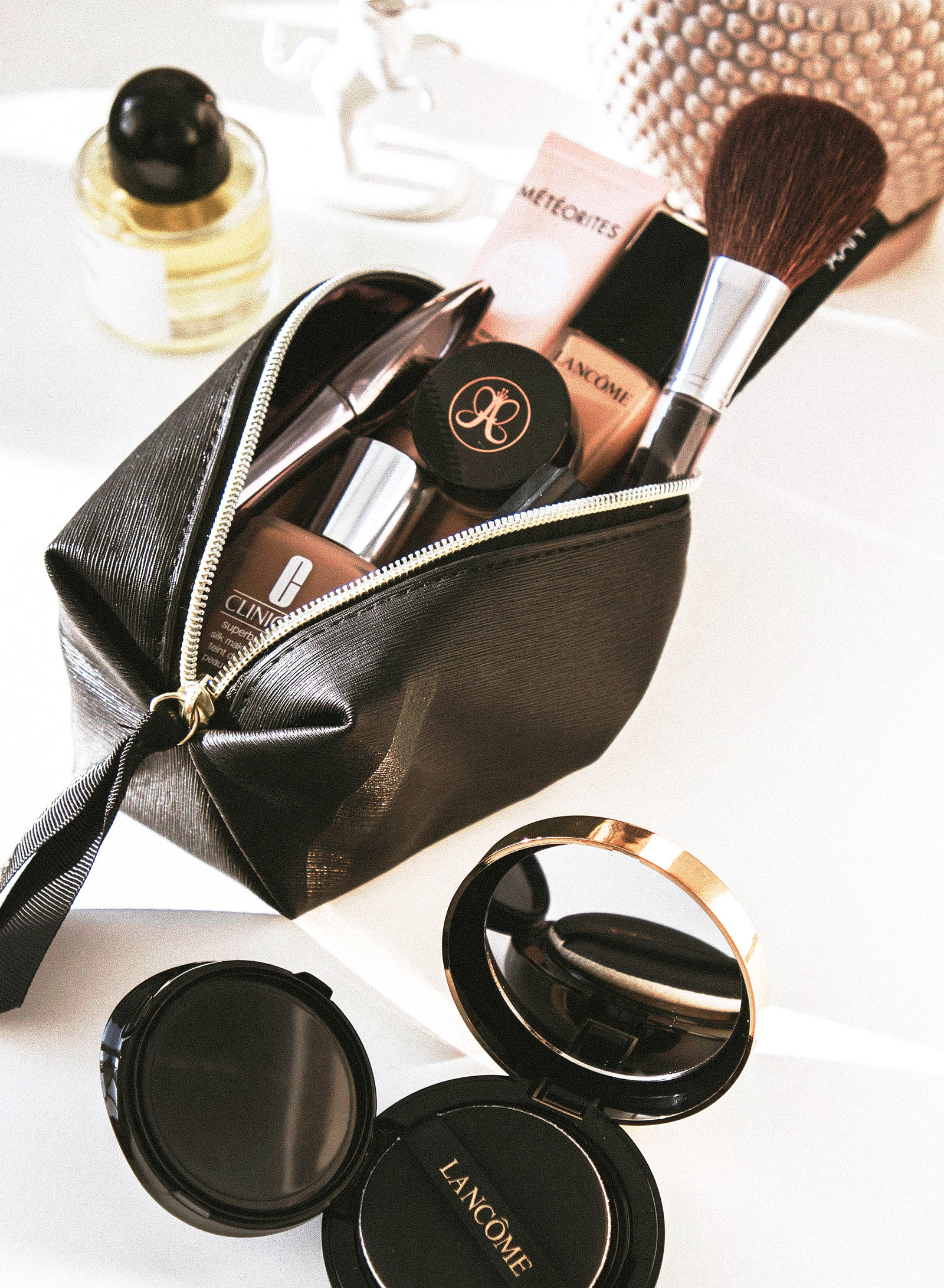
Behind the glam: Why does makeup expire
Just like that hidden best-before date on your favorite snack, makeup has its ticking clock. But what exactly triggers the countdown on our beloved beauty essentials?
Prepare to immerse yourself in the (sometimes) surprising reasons behind why does makeup expire in this deep dive.
The circle of life: Makeup’s natural deterioration
All things, whether organic or synthetic, have a life cycle. This is true for the mighty oak tree and equally true for that glitzy eyeshadow palette!
Over time, chemical reactions like oxidation, evaporation, and hydrolysis occur in makeup products, which result in the breakdown of their primary ingredients. This means that even if you never open that bottle of foundation, its formula is subtly changing over time.
Bacteria: The unwanted guests
Every time we open a makeup container, bacteria from the air and our skin get a chance to invade the product. This is especially true for products we apply directly with our hands or those we use near our eyes and mouth.
Think about it: That mascara wand touches your lashes, which are close to a naturally moist area (your eyes), and then goes right back into the tube, creating an ideal breeding ground for bacteria. Over time, the buildup of these microorganisms in your makeup can lead to infections or skin irritations.
Natural vs. synthetic: The preservation challenge
Natural and organic makeup products have gained popularity due to their absence of synthetic chemicals and potential irritants — especially for sensitive skin.
However, these synthetic preservatives give many makeup products a longer shelf life. Without them, natural products can quickly become a hotspot for microbial growth. So, yes they may be free from certain chemicals but often have a shorter expiry date.
Air and light: Enemies in disguise
Another answer to ‘why does makeup expire’ lies in the environmental conditions. Exposure to air can lead to the oxidation of makeup products, especially liquid ones like foundation. Oxidation can change the product’s color and consistency, making it less effective or even potentially harmful.
Similarly, direct exposure to sunlight or even strong indoor lighting can degrade the quality of certain ingredients, leading to reduced efficacy and a shorter shelf life.
External factors: Temperature and humidity
Have you ever left your lipstick in a hot car? Heat can melt and change the consistency of makeup products.
Conversely, cold can harden or cause separation in some products.
Moreover, high humidity can introduce moisture into products, making them more susceptible to bacterial contamination. That’s why bathroom cabinets may not be the ideal place you think them to be!
The product’s integrity: Its purpose and potency
Apart from the health concerns, there’s the matter of the product’s efficacy when talking about ‘does makeup expire.’
Over time, the active ingredients in makeup, like those that provide SPF protection in a tinted sunscreen or anti-aging benefits in a foundation, become less potent.
This means even if an expired product doesn’t irritate your skin, it might not provide any of the initially promised benefits.
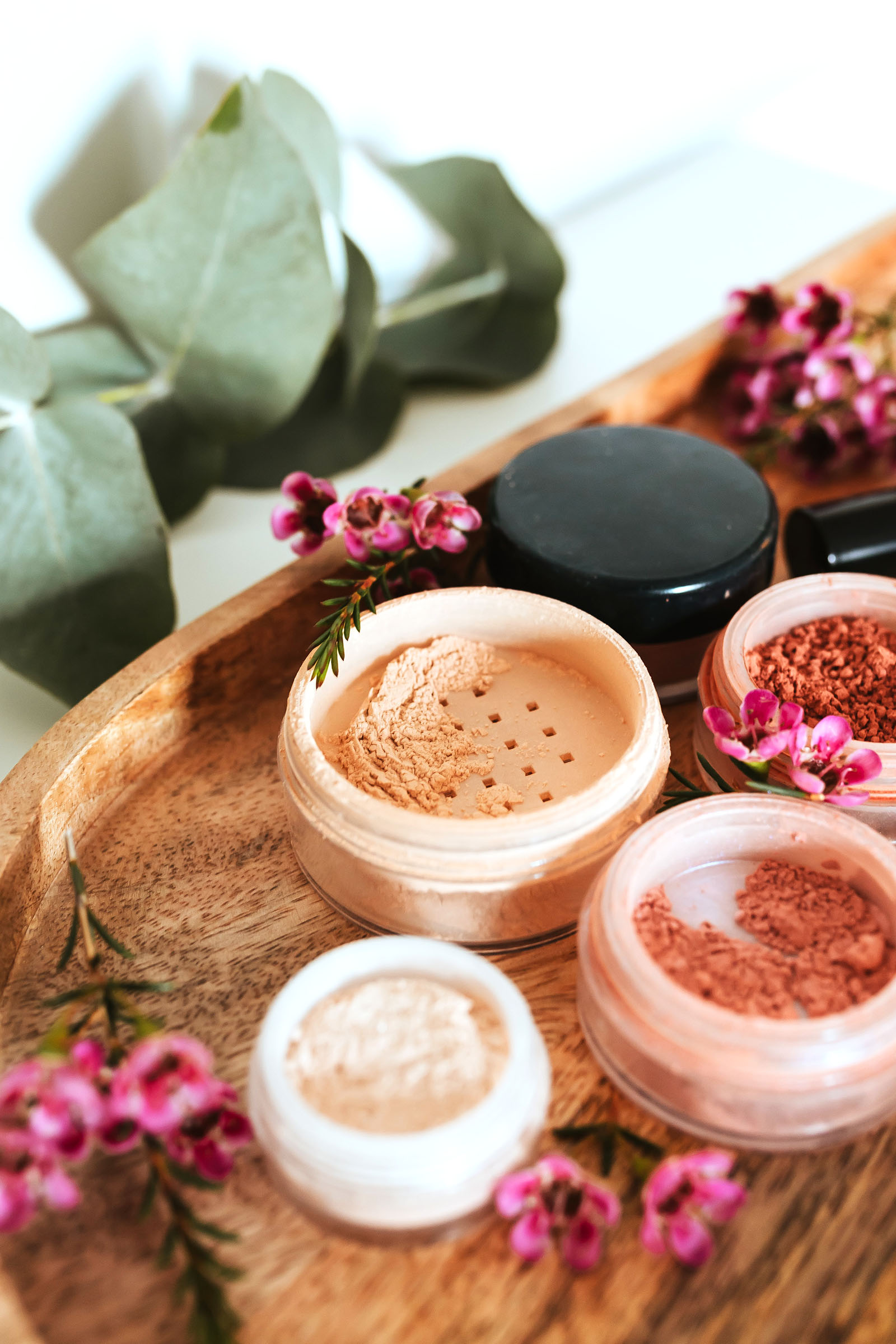
Signs, signs, signs: The ultimate guide to detecting expired makeup
Our senses are equipped to detect changes in our environment, including the makeup we apply to our skin. By being vigilant and regularly checking your makeup stash, you ensure that your beauty routine remains both glamorous and safe!
The scent test: A telltale warning
Every makeup product has its distinct aroma. Over time, as products degrade, this smell can morph into something less pleasant. Trust your nose; it’s usually the first alert system.
If your once fragrant nail polish now smells sour or your lipstick emits a rancid odor, it’s time to bid farewell.
Texture troubles: Feel the difference
The consistency of makeup products can reveal a lot about their condition. When products change in texture, it’s a sign that they might not be safe for use.
- Creams & liquids: If they’ve become lumpy, overly thick, or separated into different layers.
- Powders: If they’ve hardened or become difficult to apply.
- Mascaras: If they’ve dried out or become clumpy.
Color changes: A visual cue
Color shifts are more than a faded look; they can indicate chemical changes within the product. If your foundation seems more orange than beige or your vibrant eyeshadow looks dull, it’s a sign that it’s past its prime.
Separation anxiety: Components parting ways
Liquid products like foundations or liquid eyeliners can separate into different layers when they expire.
While minor separation can occasionally be fixed with a good shake, consistent separation indicates that the product is no longer stable.
Performance pitfalls: When it just doesn’t work
An obvious sign of aging makeup is when it no longer does its job effectively.
Foundations that don’t blend well, eyeliners that smudge more than usual, or lipsticks that don’t glide on smoothly all indicate that the product might be past its peak.
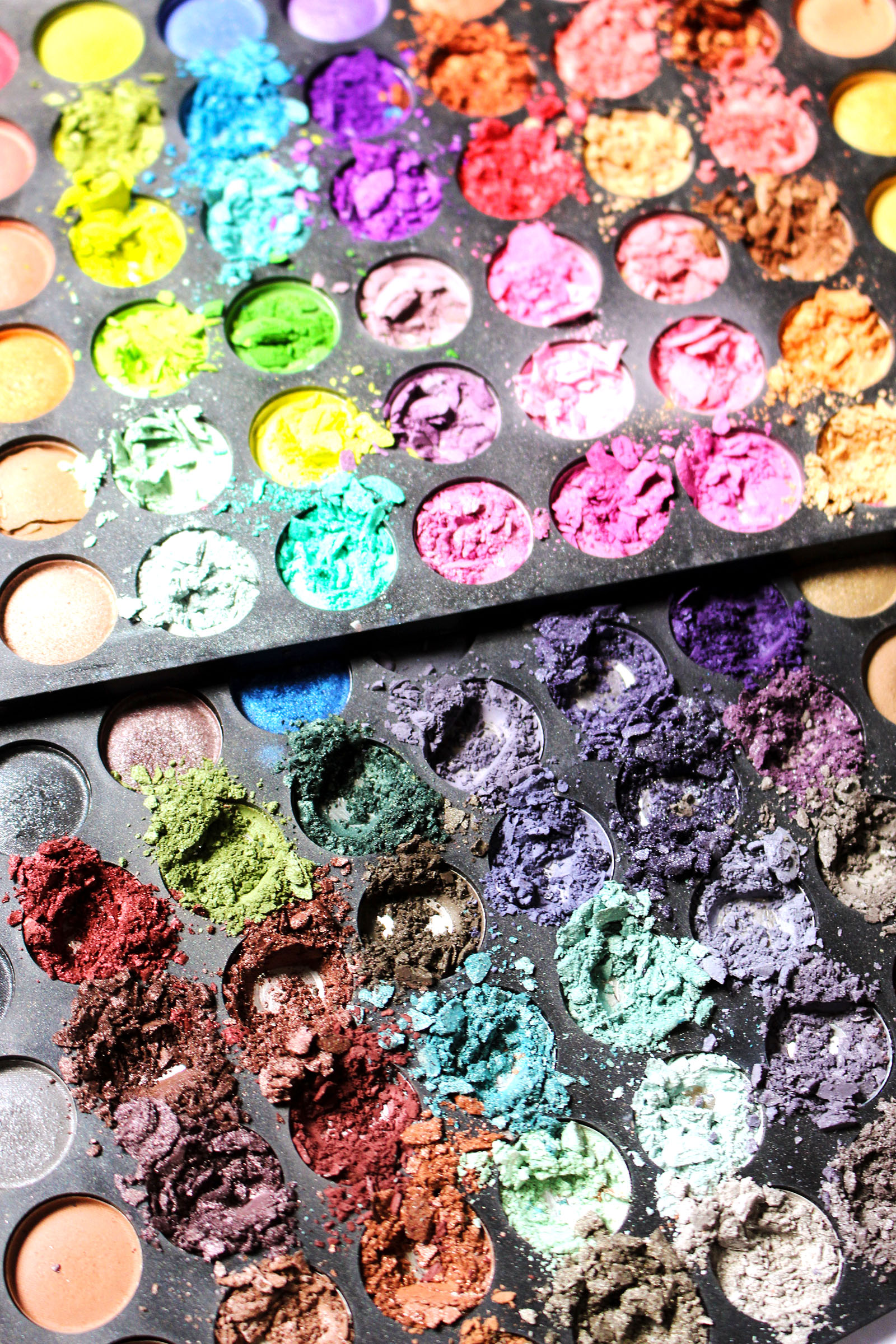
Packaging clues: The outer tells the inner tale
Sometimes, the exterior gives hints about the product’s condition.
If the packaging is bloated, it could mean bacterial growth inside.
Similarly, there are clear danger signs if the product leaks or has mold around the lid.
Skin reactions: The unmissable SOS
If a product that once felt great now causes itching, redness, allergic reactions, or irritation, it’s a massive red flag. Our skin can react adversely to the bacteria or the breakdown of compounds in expired makeup.
Always perform a patch test if in doubt, especially with products sitting around for a while.
When does makeup expire: The lifespan of your essentials
While these timelines offer general guidelines, always prioritize your senses and skin’s reactions. Store products correctly, avoid cross-contamination, and remember that fresher is always better in the realm of beauty.
Remember: Makeup remains in close contact with our skin, eyes, and lips. For the sake of beauty and health, staying informed is crucial.
Mascara and gel or liquid eyeliner: 3-6 months
Wet cosmetics such as mascaras and liquid eyeliners, which are packed in dark, narrow containers, are a petri dish for bacteria — and you’re going to use them next to your eyes!
Every time you pull out the wand and reintroduce it into its tube, you’re potentially trapping bacteria inside, making these items expire more rapidly than others.
Plus, every time you pump the wand into the mascara tube, it pushes air into the formula, drying it out and making for a not-so-smooth application. If you notice any change in smell or consistency, or if the mascara starts flaking more than usual, it’s time to toss.
Tinted sunscreens: 6 months to one year
Skincare products, especially those with active ingredients, can lose efficacy over time. Sunscreens, in particular, are crucial to monitor. If they expire, they might not offer the promised protection level. Always check for changes in color, consistency, or separation of ingredients.
Foundations and concealers: One year
Liquid foundations, especially water-based ones, can become a breeding ground for bacteria.
With time, liquid makeup thickens and separates, making for a patchy finish. It even starts changing color due to oxidation, which explains why an old liquid foundation does not sit as well on your complexion as a fresh one. Signs they’re past their best include separation of ingredients, color changes, or a funky smell.
Stick and powder foundations may last longer, but monitoring them for changes in texture or scent is still essential.
Blushes, bronzers, highlighters, and other cream products: 6-12 months
Cream products retain more moisture, making them susceptible to bacterial growth and decreasing shelf life compared to their powder counterparts.
Eyeshadows, blush, and other powder-based makeup: 1-2 years
If you’re not touching powder-based makeup with dirty hands or brushes, it runs a lower risk of feeding bacteria as there is no water to aid their growth.
However, with time, powder products start drying out, crumbling, and becoming clumpy, making application difficult. So, if they begin developing a hard crust, change in color, or lose their pigmentation, it might be their end of days.
And yes, those fancy palettes, too, have a retirement age.
Some also contain botanical ingredients, like aloe vera or essential oils, which are more prone to bacterial contamination. So, keep an eye out for any growth or change in consistency and toss it out immediately if that happens.
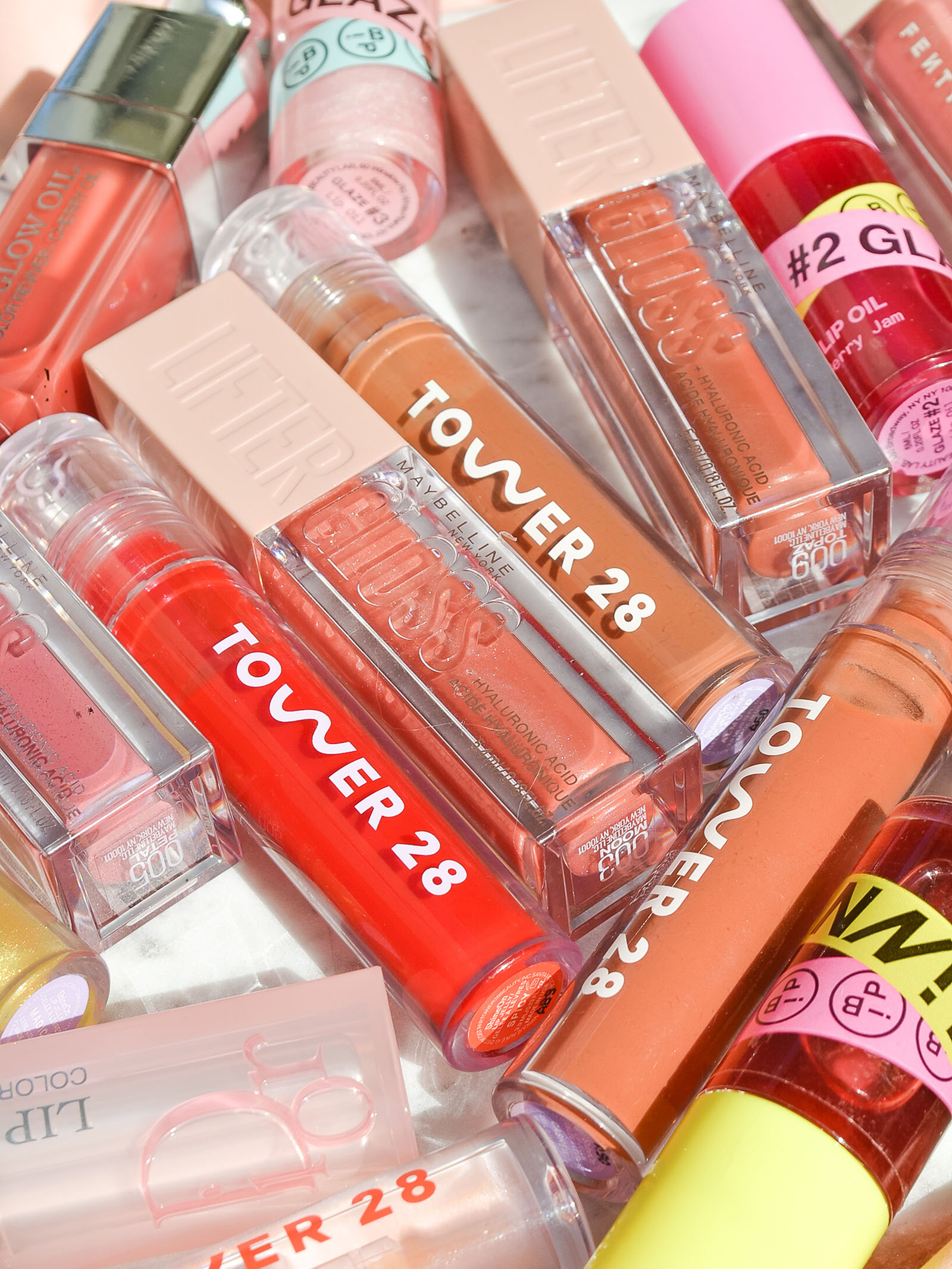
Lipsticks and lip glosses: Up to two years
This is the question I am asked most often: Does lipstick expire? And the answer is a definite yes!
Lipsticks are loaded with wax, water, and emollients, which draw in bacteria and become mini-reservoirs of infections.
They also contain oils that go rancid with time.
Plus, they start drying out as the water evaporates, causing a drag on lips rather than the creamy or glossy effect you seek.
PS: If you’ve had a cold sore, any lip products you use at the time have to go immediately. Apologies!
Lip pencils and eye pencils: Up to two years
Pencils usually go very close to mucous membranes, increasing the chances of picking up bacteria and transmitting them back to your eyes and lips.
However, every time you sharpen a pencil, it removes the contaminated layers and reveals a fresh, clean one. This extends their shelf life.
The only caveat: Regularly sanitize your sharpener and toss out the pencil eyeliner or lip liner immediately if you have any cold sores or eye infections (like pink eye). Also, remember that self-sharpening pencils don’t have the same benefits and need to be tossed out after 3-6 months.
And if the pencil becomes overly dry, hard to apply, or changes in color, it’s time to sharpen it for the last time.
Nail polishes: Up to two years
While they might seem invincible, even nail polishes can go bad. When the solvents in nail polishes evaporate, the formula will start separating, becoming thick, clumpy, and hard to apply.
This will happen sooner if the nail polish is exposed to heat and humidity. And while thinners can sometimes resurrect an old polish, it’s not always a guarantee.
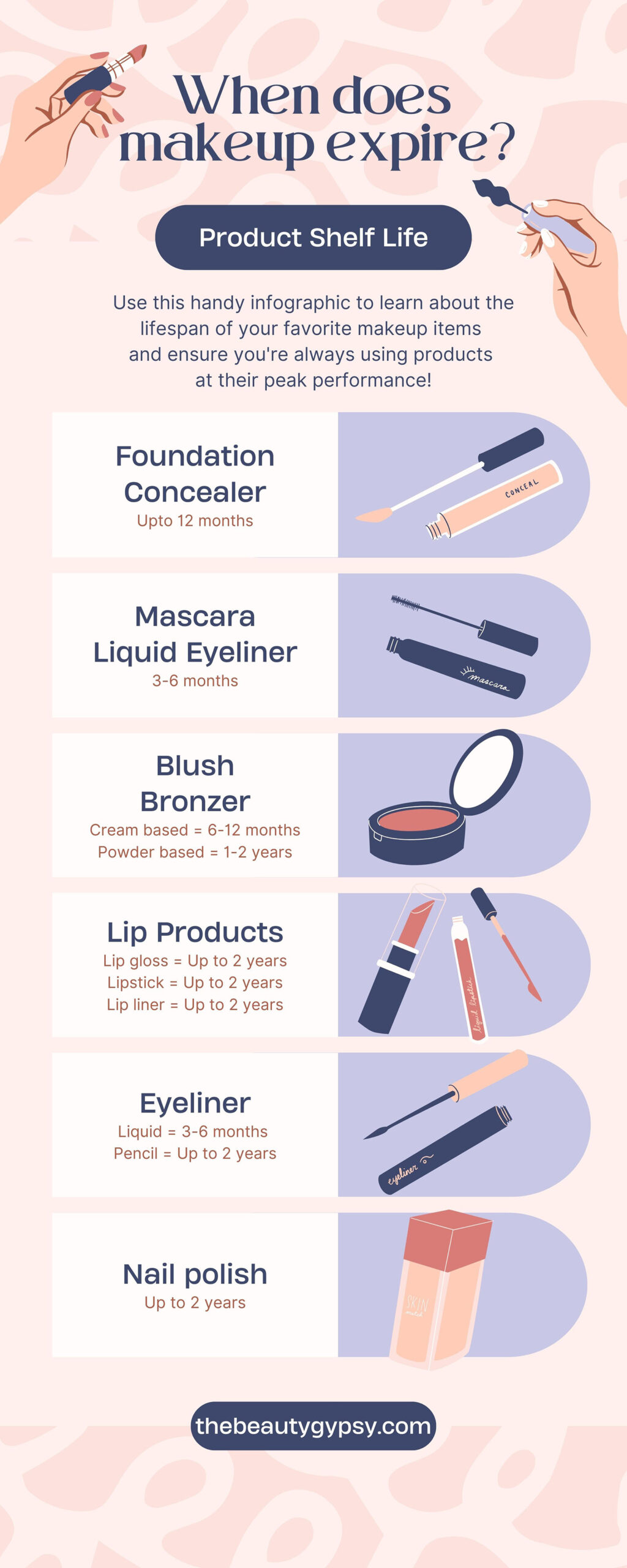
Preservation tactics: How to extend the life of your makeup
Does makeup expire? Yes.
Can you extend its life with certain hacks? Also, yes.
By following these preservation tactics, you ensure your makeup looks its best and optimize its lifespan, giving you more glam for your buck!
Read the label!
Unfortunately, due to a lack of regulation, most cosmetics don’t have an expiry date printed on the label — which makes it difficult to say when does makeup expire.
Instead, you may find a Period After Opening (PAO) date, usually indicated by the illustration of a jar with a number written in it. So, a pot with “12” or “12M” would mean the product is suitable for 12 months after opening.
A cool, dry space
Store your makeup in a cool and dry location, away from direct sunlight.
High temperatures can accelerate the breakdown of compounds, while direct sunlight can degrade some ingredients.
Also, ensure your storage area isn’t overly humid to prevent bacterial growth.
Hands off!
Every time you touch makeup products with your fingers, you’re introducing oils, bacteria, and other contaminants.
Instead, use spatulas for creams, makeup brushes for powders, and ensure these tools are clean. A quick wipe or a wash post-application can significantly reduce the transfer of unwanted microbes.
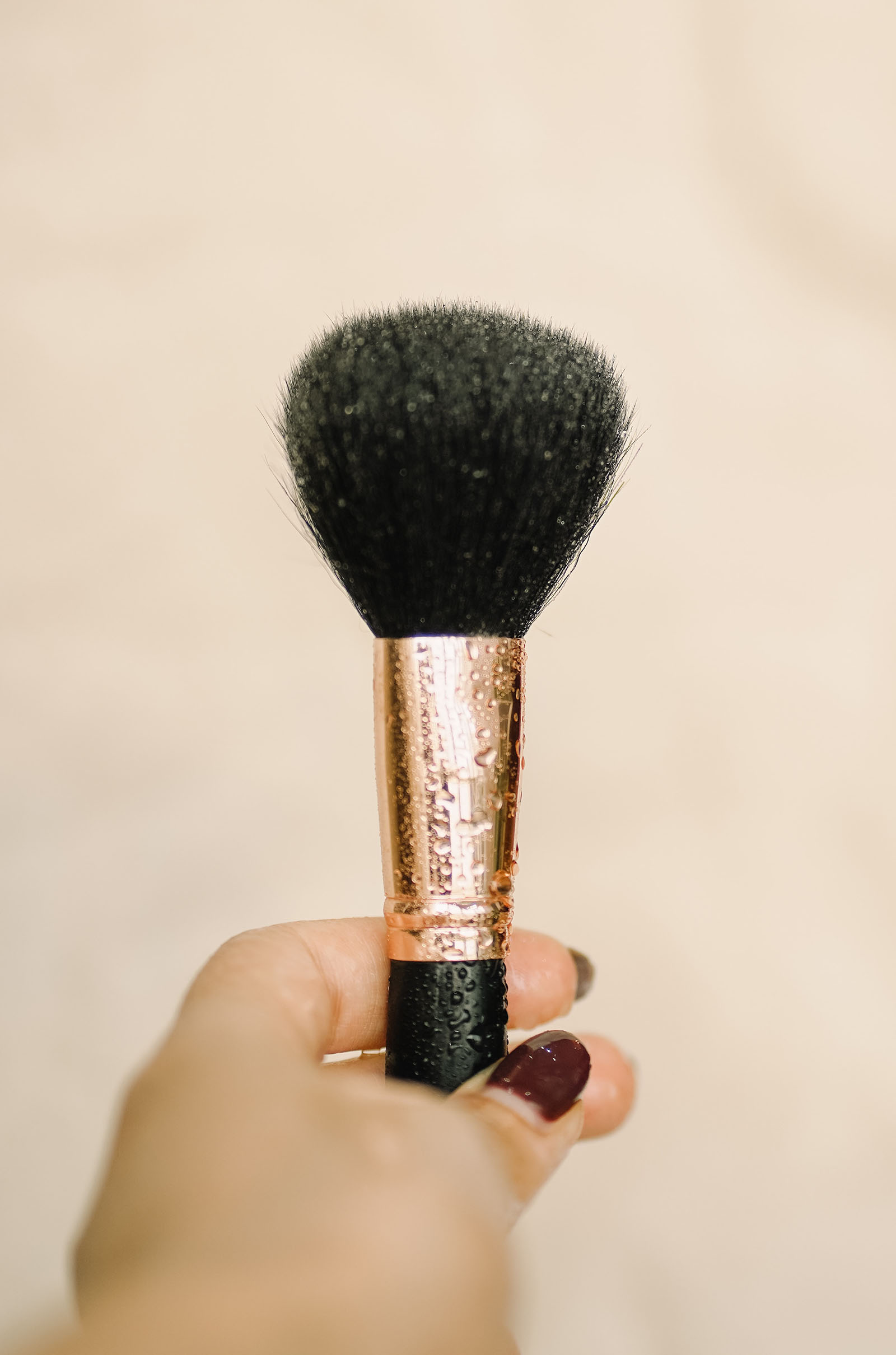
Seal it tight
Ensure lids and caps are securely fastened after every use. Minimizing exposure to air can reduce the risk of oxidation and contamination.
If a product’s packaging breaks, consider transferring it to an airtight container or investing in quality packaging for longer shelf life.
Clean (makeup bag) sweep
Periodically clean out your makeup bag. Wipe down products and containers with a damp cloth or an alcohol swab to remove dirt, dust, and bacteria. A clean storage environment ensures a longer-lasting product.
Sharp thinking
Regularly sharpening makeup pencils, like eyeliners and lip liners, can help to remove the outer layer that might have been exposed to bacteria.
This ensures the product you’re applying is fresh and reduces the risk of transferring bacteria onto your skin.
One at a time
Instead of pumping your mascara wand multiple times (which pushes air and bacteria into the tube), swirl the brush inside to get the product on it.
Similarly, if using liquid foundations or other pump-based products, try to get the needed amount in one or two pumps rather than repeatedly exposing the product to air.
Do the dates
Whenever you purchase a new makeup product, mark the date on the packaging with a permanent marker. Knowing when you opened a product can help you assess its longevity more effectively than relying on memory alone.
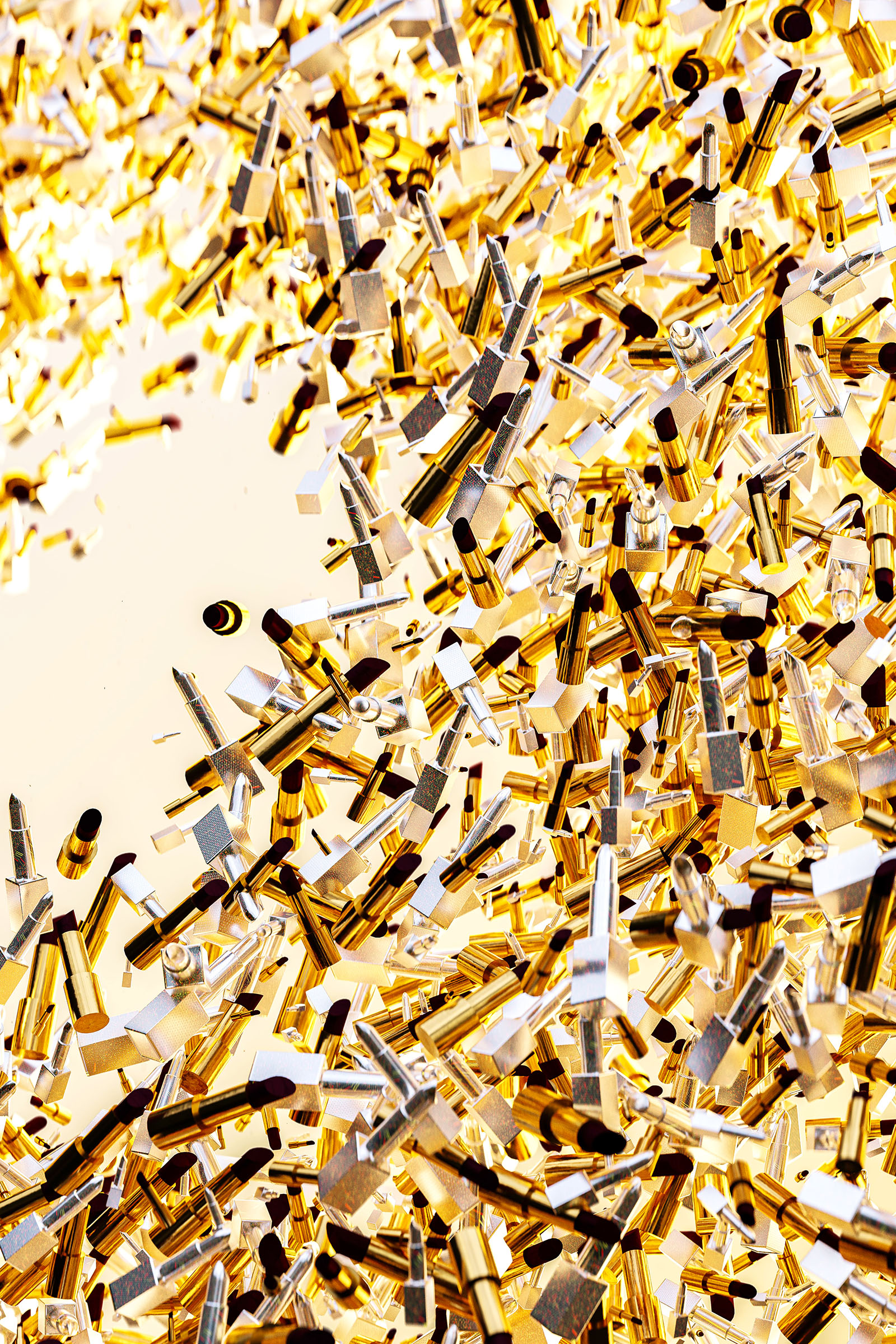
FAQs: Why does makeup expire?
These are the most frequently asked questions about makeup expiry dates. Have one of your own? Pop it in the comments below.
Why does makeup expire?
Makeup products can degrade due to chemical reactions, bacterial growth, and the breakdown of active ingredients, compromising their safety and effectiveness.
Is it OK to use expired makeup?
Generally, no. Expired and old makeup can harbor bacteria, leading to skin irritations, infections, and other adverse reactions.
How do I know if my makeup is expired?
Besides checking the expiration date, monitor for changes in texture, color, and smell. Any alteration might indicate that the product is past its prime.
Can you use makeup from 2 years ago?
Some products, like certain powders, might still be usable. However, liquid products, especially those around the eyes, are less likely to remain safe after this time.
Can you use 10-year-old lipstick?
It’s definitely not recommended. Over such an extended period, ingredient degradation, bacterial growth, and potential skin irritants are highly likely.
Does eyeshadow expire?
Even though powders have a longer shelf life, eyeshadows, especially creamy or liquid formulations, can degrade and become a haven for bacteria over time.
Does makeup expire if left unopened?
Yes, even unopened products will eventually expire due to the natural degradation of their ingredients over time.
Can I refrigerate my makeup to make it last longer?
Not all makeup benefits from refrigeration. While it can extend the life of some products, others, especially creamy formulas, may alter in texture if stored cold.
Why do some products have an open jar symbol with a number?
This symbol, known as the Period After Opening (PAO) symbol, indicates the number of months the product is expected to last after it’s opened.
Can I remove the mold on my lipstick and use the rest?
No, if there’s visible mold on any part of your makeup, discard the entire product, as microbes might have burrowed deep into the tube.
What do YOU think? Does makeup expire? Or it just a beauty myth?

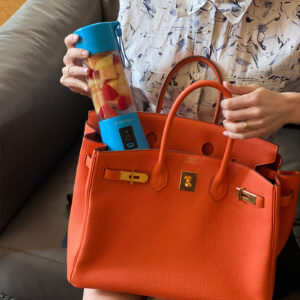

Immi says
Great experience after reading your article. Please must next time write about the oil products for skin expiration and the effects of its usage like Azure Oil Serums. Thank you for sharing with us waiting for your next great article.
Rose Best LLC says
Thanks for sharing this nice post.I like your post too much.This is really too good